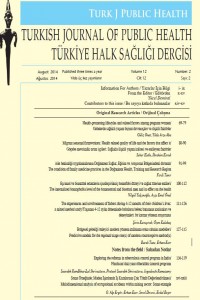Bölgesel gebeliği önleyici modern yöntem kullanma oranı tahmin modelleri
Abstract
Amaç: Türkiye’de Aile hekimliği sürecinde 15-49 yaş kadın nüfusa yönelik aile planlaması sürveyansı aksamaktadır. Çalışmamızda modern aile planlaması kullanım sıklığı üzerine etkili faktörlerin dâhil edildiği tahmin modelleri yardımıyla bölgesel modern yöntem kullanım sıklıklarını tahmin edebilmek amaçlanmıştır.
Yöntem: Ekolojik tipte bir araştırmadır. Uluslararası ve ulusal veriler yardımıyla Modern aile planlaması yöntem kullanım sıklığını tahmin etmek istenmiştir. Tahmin modelleri: Adımsal Çok Değişkenli Doğrusal Model; bu modelde bağımlı değişken modern AP kullanımı, bağımsız değişkenler ise toplam doğurganlık hızı, 15 yaş üzeri kadınların ortalama eğitim süresi, kişi başı gayri safi yurt içi hâsıla verileri, , kadınlar için ortalama ilk evlenme yaşı belirlenmiş ve 164 ülke verisi kullanılmıştır. Tek Değişkenli Doğrusal Modeller; Diğer verilere ulaşılamayacağı düşünülerek toplam doğurganlık hızıyla 2 ayrı model (164 ülke verisi ve 2008 TNSA bölge verileri) kurulmuştur.
Bulgular: Adımsal Çoklu Doğrusal Regresyon Modelinde R2 0.503bulunmuş ve modelin anlamlı olduğu görülmüştür. Anlamlı bulunan değişkenler, toplam doğurganlık hızı (TDH) ve kişi başına düşen gayri safi yurt içi hâsıla değeridir. Model denklemi: (y)= 56.401 – 7.127 X (x1) + 0.001 X (x2) (y) = Gebeliği önleyici modern yöntem kullanım oranı (x1)= Toplam doğurganlık hızı(x2)= Kişi Başına Düşen GSYİH Basit Doğrusal Regresyon Modelleri; 2 ayrı basit doğrusal regresyon modelinin açıklayıcılık düzeyleri 0.421 ve 0.600’dur. Ülke verileri ile kurulan model (y1) = 71.645-10.215 x (X1) 2008 TNSA bölge verileri ile kurulan model (y2) = 58.031-6.739 x (X1) (y)=Gebeliği önleyici modern yöntem kullanım oranı (x1)= Toplam doğurganlık hızı
Sonuç: Bölgesel modern AP sıklığı tahmini için oluşturduğumuz 3 ayrı modele ait açıklayıcılık düzeyi diğer çalışmalarla uyumlu gözükse de tahminler bölge düzeyinde tutarsızlıklar göstermiştir.
Predictive models for the regional usage rate(s) of modern contraceptive method(s)
Abstract
Objective: The aim of this study is to predict a prevalance ratio for regional modern family planning (FP) methods with the help of forecasting models that include factors related to modern family planning methods.
Methods: Ecological research that aimed to predict the prevalance of modern family planning methods was performed using reliable international and national data. Prediction models: Stepwise multi-variate linear regression model: The prevalance of modern FP methods was used as dependent variable; total fertility rates, the average number of years of schooling for women, per capita Gross Domestic Product (GDP) and average age at first marriage for the women were used as the independent variables. Data from 164 countries were included in the model. Simple linear regression model: Two seperate models (data from 164 countries and data from the 2008 Turkey Demographic and Health Survey) were constructed using only total fertility rate (TFR) because other data could not be reached.
Results: The stepwise multi-variate linear regression model’s R2 value was 0.503 and the model that included the total fertility rate and per capita GDP was found to be significant. Model equation: (y)= 56.401 – 7.127 X (x1) + 0.001 X (x2) (y) = prevalance of modern family planning methods (x1)= total fertility rate, (x2)=per capita gross domestic product Simple linear regression model’s R2 belonging to two separate groups; R2; 0.421-0.600 Countries’ data model (y1) = 71.645-10.215 x (X1) 2008 TDAHS areas’ data (y2) = 58.031 -6.739 x (X1) (y)=modern family planning methods prevalance, (x1)= total fertility rate Conclusion: The explanatory level of three different models is in accordance with other studies but shows inconsistencies at the regional level.
Details
| Primary Language | Turkish |
|---|---|
| Subjects | Health Care Administration |
| Journal Section | Original Research |
| Authors | |
| Publication Date | August 22, 2014 |
| Submission Date | December 12, 2015 |
| Published in Issue | Year 2014 Volume: 12 Issue: 2 |
Cite
TURKISH JOURNAL OF PUBLIC HEALTH - TURK J PUBLIC HEALTH. online-ISSN: 1304-1096
Copyright holder Turkish Journal of Public Health. This work is licensed under a Creative Commons Attribution-NonCommercial-NoDerivatives 4.0 International License.

